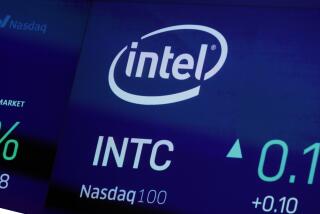Intel plans $7 billion in upgrades
- Share via
SAN FRANCISCO — Intel Corp. plans to spend $7 billion upgrading its U.S. factories over the next two years, a sign that the recession hasn’t extinguished chip makers’ thirst for cutting-edge equipment.
The company’s investment, announced Tuesday by Intel Chief Executive Paul S. Otellini in a speech in Washington, speaks to the semiconductor industry’s need to keep investing heavily regardless of the poor economic climate that has led Intel to cut jobs.
The investment could be a boon to companies that produce chip-making equipment, such as Applied Materials Inc. and KLA-Tencor Corp., and is another example of how Intel’s deep pockets have kept rival Advanced Micro Devices Inc. at bay.
Intel, based in Santa Clara, Calif., is struggling with the worst PC market in years. Overall semiconductor sales fell in 2008 for the first time in seven years, slipping about 3% to $249 billion, according to the Semiconductor Industry Assn.
Yet Intel says its latest investment is the most it has ever spent on a transition to new manufacturing technology.
Every couple of years, chip companies make the multibillion-dollar switch to new equipment that makes possible chips with smaller and smaller circuitry. The change lets them make each chip more powerful and is essential to maintaining Moore’s Law, the prediction by Intel co-founder Gordon Moore that the number of transistors on a chip will double about every two years.
Moore’s Law has been the industry’s benchmark for technological progress for more than 40 years, but chip makers are finding it harder to maintain because of physical limitations of the materials used in making microprocessors.
Intel said the $7 billion would pay for new machinery at factories in Oregon, Arizona and New Mexico, which will be outfitted to produce chips based on 32-nanometer technology. The most advanced chips are currently made with transistors as small as 45 nanometers wide. Intel says 2,000 of those transistors would fit across the width of a human hair.
But Intel’s investment doesn’t necessarily mean that lots of jobs will be created.
The money will pay the salaries of about 7,000 “high-wage, high-skill” jobs that already exist at those plants.






